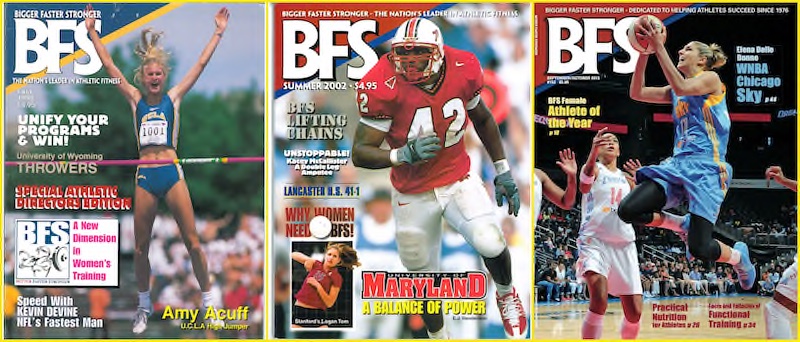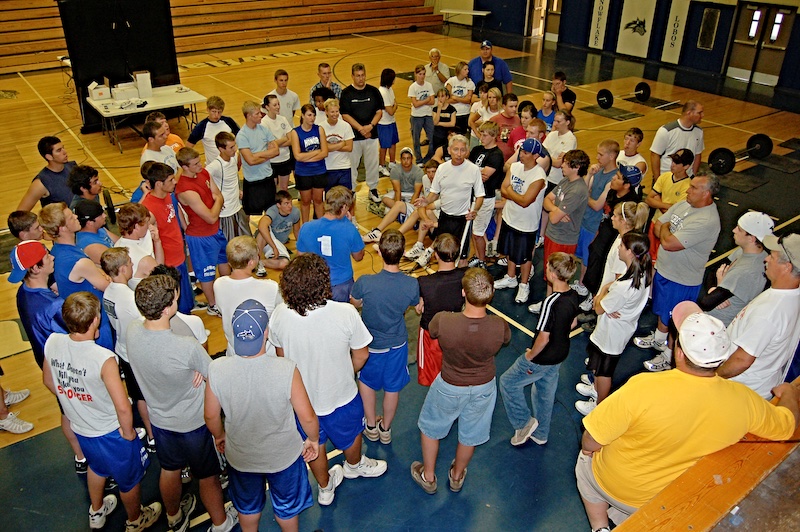
Bob Rowbotham is a former physical education teacher who coached football and wrestling. He is the CEO of Bigger Faster Stronger, running the company with his son John, who serves as the president and director of education. For nearly a half-century, BFS has been one of the most influential forces in athletic fitness training for young athletes. Working with athletic and physical education departments, BFS coaches have given over 10,000 hands-on clinics for athletes and their coaches. It was also known for its print magazine, BFS, which was published bimonthly for nearly four decades and distributed to over 17,000 high school, college, and professional sports programs.
Freelap USA: BFS promotes the unification of athletic programs in high schools. How do you define unification, and why do you think it’s important?
Bob Rowbotham: Unification is the belief that all sports and physical education classes should teach the same weight training techniques and follow the same program design structure. Unification enhances sports performance and ensures total physical development in the general student population.
Rather than having a stretching program for football, one for wrestling, one for baseball, and one for PE classes, all students follow the same stretching program year-round. Rather than having separate weight training programs, there would be one program that focused on the same core lifts year-round. The result is that a unification program reduces the amount of coaching needed to get athletes and the general student population ready to work hard in the weight room.
Freelap USA: How was the BFS program created?
Bob Rowbotham: The inspiration for the BFS program came from the workouts of elite track and field throwers, including George Frenn (hammer throw), Stefan Fernholm (discus), and Jon Cole (discus and shot put). Frenn squatted a world record, Fernholm could power clean 476 pounds and vertical jump over 40 inches, and Cole was the first man to squat 900 pounds officially. Brigham Young University was the first college team to use the BFS workout, and the Utah Jazz was the first professional team.
Consider that when BFS started, most athletes who lifted weights were football players. Following the workouts of these powerful track and field athletes made sense. That environment has changed, with most sports wanting to enjoy the benefits of pumping iron. However, we found that the training methods used by those elite track and field athletes could benefit all athletes, even athletes in distance events.

Freelap USA: BFS has a reputation for turning around sports teams, frequently featuring these teams in your magazine. What advice would you give to other coaches who want to get their athletes back on the winning track?
Bob Rowbotham: One way to turn around weak sports programs is to focus on breaking personal records in the weight room. With our set/rep system, it’s common for an athlete to break a dozen personal records a week, year-round. This positive reinforcement gives athletes confidence, and good things happen when you believe in yourself.
One way to turn around weak sports programs is to focus on breaking personal records in the weight room. This positive reinforcement gives athletes confidence, which leads to good things happening. Share on XIn team sports at the high school level, talented athletes tend to cancel each other out. Rather than focusing on turning great athletes into superstars, making good athletes better can help elevate the overall talent of a sports team. Let me give you an example. It’s a daunting task for an undersized high school football lineman to face off against a 250-pound lineman. But if that undersized athlete can parallel squat 300 pounds and deadlift 400 pounds, he will have the mentality that he can do something against that opponent.
Another way to get an edge over schools is by starting athletes in strength and conditioning in feeder middle schools with a teaching system we call the BFS Readiness Program. This program teaches the basic lifts, how to spot, and how to properly stretch, jump, and sprint—heavy lifting isn’t emphasized, just technique. When these athletes move on to high school and have the physical maturity to lift heavy, they can get going from day 1 rather than going through a long introductory period.

Freelap USA: What are the physical and mental differences that coaches and PE instructors should be aware of in kids now versus when you started teaching?
Bob Rowbotham: Physically, there’s little difference. That said, in the past, with PE classes, kids had to master one fundamental skill before moving on to another—that’s not the case now in many PE programs. Also, one of the worst things happening in the country is PE being taken off the required curriculum list, so kids never find out how much potential they have in sports.
Mentally, many young athletes today display a negative work ethic. Coaches I’ve talked to agree, saying that many kids today expect to be good without paying the price of hard work, and this attitude is difficult for a coach to deal with because there is so much influence by society. This challenge inspired us to develop a character education program called “Be an 11.”
The feedback we get from school administrators is that when athletes behave like role models, there’s a positive trickle-down effect on the entire student population. Share on XThe “Be an 11″ program focuses on working with athletes rather than the general population. A coach works with a team where everyone is focused on winning and achieving the same goals. The feedback we get from school administrators is that when athletes behave like role models, there is a positive, trickle-down effect on the entire student population.
Freelap USA: BFS believes high school athletes should play multiple sports. Wouldn’t it be better for athletes to focus on a single sport to increase their chances for a scholarship?
Bob Rowbotham: The highest level of sports competition for more than 90% of athletes is high school. It would be a shame for the less physically gifted athletes to focus on just one sport and miss out on the total high school sports experience. Also, the risk of injury, particularly overuse injuries, is much higher in athletes who play only one sport.
Next, having athletes play only one sport affects the success of the overall athletic program and can devastate smaller schools. That starting quarterback could be a point guard for the basketball team and a pitcher for the baseball team. That star volleyball player could be a center on the basketball team and a high jumper in track. Let me finish with one more point.
For athletes seeking a scholarship in team sports, consider that the success of an athlete in a team sport is influenced by the talent surrounding them. A less-talented running back with a strong offensive line may put up more impressive numbers than a more-talented running back with a weak offensive line. Seeing how this athlete performs in other sports, particularly track and field, gives college scouts a better understanding of an athlete’s athletic potential.
Since you’re here…
…we have a small favor to ask. More people are reading SimpliFaster than ever, and each week we bring you compelling content from coaches, sport scientists, and physiotherapists who are devoted to building better athletes. Please take a moment to share the articles on social media, engage the authors with questions and comments below, and link to articles when appropriate if you have a blog or participate on forums of related topics. — SF

